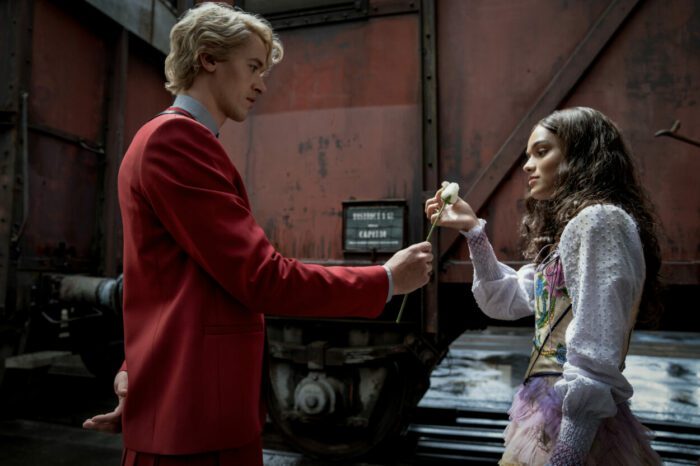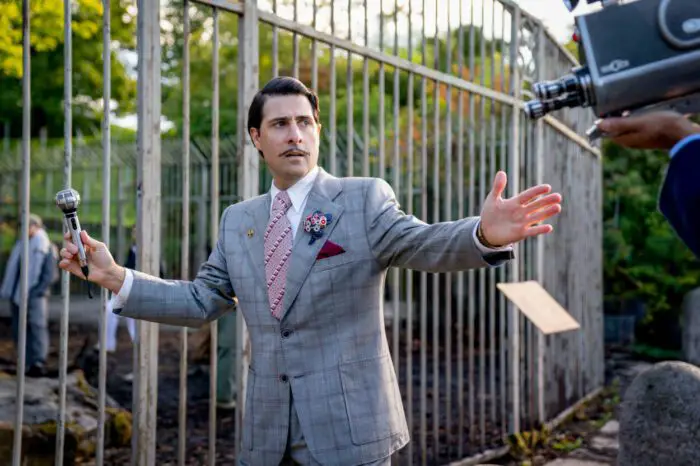At one point during The Hunger Games: The Ballad of Songbirds and Snakes (just Songbirds and Snakes going forward), head gamemaker Dr. Volumnia Gaul (Viola Davis) asks a young Coriolanus Snow (Tom Blythe), “What are the Hunger Games for?” This one question drives this 157-minute riveting prequel both in the context of the movie and also in questioning the value of the intellectual property in 2023. Dr. Gaul may be asking this question to Coriolanus but she delivers it directly to the camera, as if she asking every audience member.
Suzanne Collins’s trilogy of The Hunger Games was a sensation and it was inevitably adapted into a four-film franchise from 2012 to 2015. The movies were, likewise, immensely popular—cumulatively grossing over $2.9 billion—and catapulted star Jennifer Lawrence to A-list status. Even though critical reception was all over the place (and definitely tanked with both parts of Mockingjay), the fans could not have been more invested and it was truly a major cultural moment. In the eight years since Mockingjay Part 2, it seems this IP has left the culture and there isn’t any footprint to be found. With the arrival of Songbirds and Snakes, the question on everyone’s mind was, “What are The Hunger Games for?”
Any apprehension or reservations people had going into Songbirds and Snakes need to be put away. This is the best Hunger Games movie. Let me take it one step further—amongst the young adult dystopian films that dominated the 2010s—this is the best one. Better than any Divergent movie. Better than any Maze Runner movie. I was delightfully surprised at how good this movie is. Not without its flaws, but Songbirds and Snakes has outstanding production design, is superbly acted, establishes the lore clearly and effectively, and, most importantly, is a darn good time at the movies.

Set over 60 years before the events of the mainline Hunger Games movies, a young Coriolanus Snow works hard in the Capitol to earn a scholarship for his once-affluent and now-poor family. He and other students are tasked with mentoring the incoming participants of the 10th Hunger Games and turning them into spectacles to increase the declining ratings of the show. Coriolanus is assigned District 12’s feisty and rebellious Lucy Gray Baird (Rachel Zegler) and the pair develop feelings as he trains her to survive the barbaric games.
To reignite interest in this franchise, you have to reinvent the Games themselves. What better way to do that than reinvent them in real-time during the movie? In the original films, the Games were this well-oiled machine, where every single aspect was planned and controlled. In TBOSAS, the Games are a mess. They take place in a small arena, barely last a few hours, and there’s no system in place to monetize the tributes—basically, it’s a show on the verge of cancellation. It only makes sense that the eventual dictator of the polished games is the one who originally came up with the idea of all these elements.
Making the Games so imperfect makes the narrative far more rich and interesting. It’s even better when the world the film inhabits is so much more lived in and established compared to any of the other installments. One major flaw of the original four movies was their inability to make Panem a memorable place. It doesn’t even come close to Hogwarts or the Shire, and I’m not saying the Panem in Songbirds and Snakes is on the elite tier, but it comes much closer. There is less reliance on CGI and more emphasis on practical sets, and you can see the impact that has. The viewer can feel the claustrophobia of the area, just like the tributes are. You feel the griminess of the districts just as you are overwhelmed by the opulence of the Capitol. There is intention and effort put into every location and it pays off extremely well. Future dystopian films need to emulate what Songbirds and Snakes does in terms of practical production design because it, to quote serious movie actor Harry Styles, “feels like a movie.”

Very often these YA films are made like comic book movies were important technical aspects like production design, editing, etc. are just thrown to the aside to capture the spectacle. One of the reasons Songbirds and Snakes is so successful is because it makes these aspects a priority, just like the elements of production design I mentioned above. The editing of Songbirds and Snakes—especially in the first two acts—is excellent and something that made the long runtime fly by. I almost thought the opening acts were moving too fast but it only made it an exhilarating experience. Unlike The Hunger Games and Catching Fire, the Games are not saved for the end of the movie and, rather, are right in the middle. I was surprised that there was almost another 50-60 minutes of the movie after the Games ended (and the pacing gets very inconsistent in Part 3), but I thought it was an interesting creative choice by director and Hunger Games veteran Francis Lawrence and kept me guessing and what was coming next,
Strong action choreography is something that was severely lacking in the OG franchise since it exclusively featured poorly-lit and nausea-inducing shaky cam fighting. All of that is ditched for shockingly brutal action that has form and purpose. The eponymous snakes make multiple appearances in the movie and that is one case where heavy CGI was utilized. Unfortunately, they look horrendous and wildly fake. I didn’t mind them when we saw them in Dr. Gaul’s deranged lab, but when they entered the area and attacked the tributes, it did take me out simply due to how awful they looked.

The initial Hunger Games movies featured exciting stars and popular A-listers who would make appearances here and there. Songbirds and Snakes follows the same playbook to fantastic dividends. Blythe and Zegler make for an electric pair and their chemistry is soaring off the screen. I bought a ton of Zegler stock after West Side Story and—Shazam: Fury of the Gods notwithstanding—I’ve made a lot of money. She’s vibrant, powerful, and a more-than-worthy successor/predecessor to icon Katniss Everdeen. Blythe is someone who I wasn’t too familiar with and was impressed. He sinks into the role of an early Coriolanus and does a strong job of showing his gradual turn to the dark side. For both stars, they’re immensely confident in their roles that, even when the film struggles in the third act, it’s because of them and an outstanding supporting cast that you stay invested in Songbirds and Snakes.
Outside of the leads, I was loving every bit of Davis’ campy and sadistic performance as Dr. Gaul. She’s having the time of her life being the epitome of evil and every line reading she has is a roller coaster that you never want to get off of. Same can be said about Jason Schwartzman’s Lucky Flickerman, a worthy ancestor to Caesar Flickerman who adds some much needed moments of humor and absurdity. Perhaps one thing the supporting cast is missing are compelling tributes, something that the 2012-2015 movies had. Sure most of them are evil and easy to root against, but barely any of them qualify as characters and are lazily written. Stronger characters outside could have helped bring some clarity and heft to the latter third of Songbirds and Snakes.

The film is segmented into three parts and, as mentioned a few times, the third act is the weakest of the three. It primarily has to do with rushing Coriolanus’ character arc. It’s no spoiler to say this story is what sets the soon-to-be-notorious leader on his path to dictatorship and, for most of the movie, you almost forget this person is going to be a villain. This is a testament to Blythe’s performance that convinces the audience to root for him at times. However, it forces the narrative to rush his decision to turn evil by the end. At the same time, though, the film will slow down to further develop the Coriolanus and Lucy Gray love story. It just feels the movie starts to run out of steam and forgets what its intentions are and what it wants to say/do about its protagonist.
The bottom line is, even with these flaws, Songbirds and Snakes should be used as a blueprint on how to make IP and franchise movies interesting and watchable. We should see the same amount of effort in the editing of the movie as we do in the fight sequences just like we should prioritize getting strong performances over putting well-known names on a poster. I would readily see four or five more extensions of this storyline if they were made with the same amount of effort and resolve.
For me, the Hunger Games represent a path to making IP and franchise storytelling something worth being excited over. May the odds be ever in the favor of those that decide to make them.




